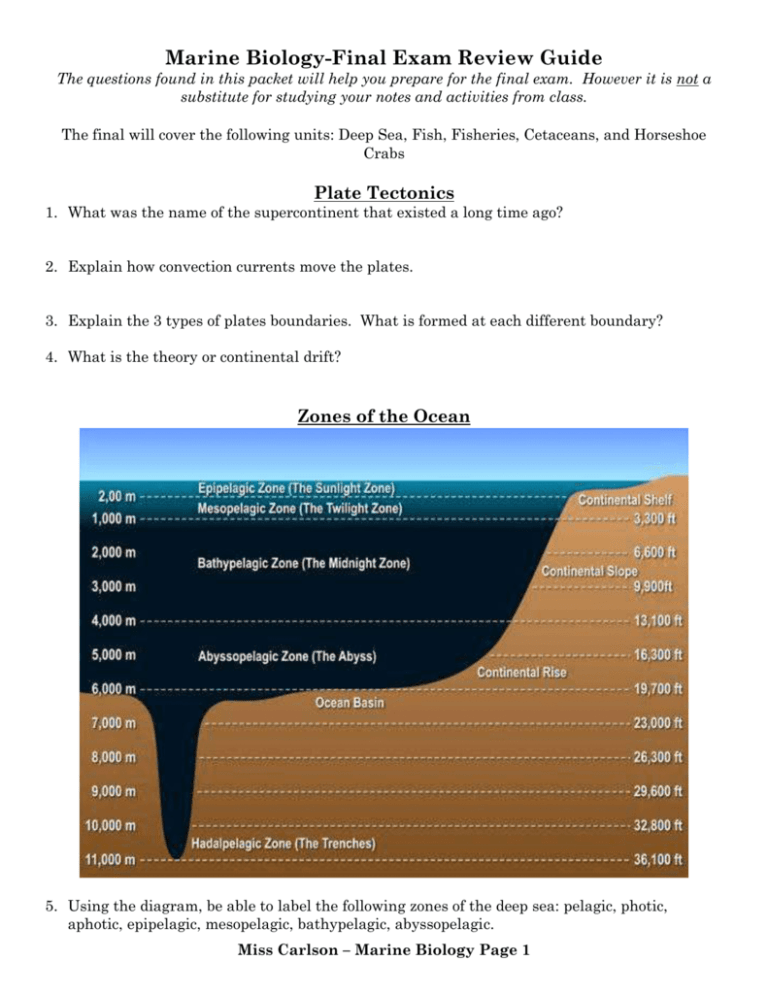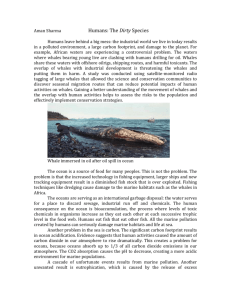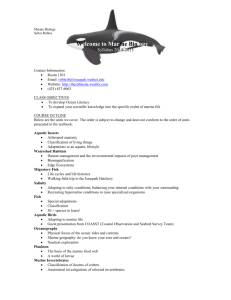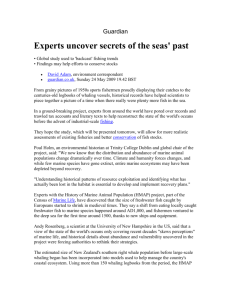Marine Biology-Final Exam Review Guide
advertisement

Marine Biology-Final Exam Review Guide The questions found in this packet will help you prepare for the final exam. However it is not a substitute for studying your notes and activities from class. The final will cover the following units: Deep Sea, Fish, Fisheries, Cetaceans, and Horseshoe Crabs Plate Tectonics 1. What was the name of the supercontinent that existed a long time ago? 2. Explain how convection currents move the plates. 3. Explain the 3 types of plates boundaries. What is formed at each different boundary? 4. What is the theory or continental drift? Zones of the Ocean 5. Using the diagram, be able to label the following zones of the deep sea: pelagic, photic, aphotic, epipelagic, mesopelagic, bathypelagic, abyssopelagic. Miss Carlson – Marine Biology Page 1 6. List the physical characteristics of each zone. Explain how light, and temperature change through these zones 7. Using the diagram above, identify the zone/zones where photosynthesis occurs. 8. Using the diagram above, identify the “Twilight Zone” Why is it called this? 9. In what area of the ocean would you find the most life? 10. Which zones are considered deep ocean? Deep Ocean Technology Unmanned/ Manned Depth Special Tools, etc. Submersible AUV ROV SCUBA Miss Carlson – Marine Biology Page 2 Expeditions it can be used for 11. What is an advantage and disadvantage these types of technology? Disadvantages Advantages Submersible AUV ROV SCUBA 12. What are the three strongest factors that humans would experience as they descended through the ocean zones? What type of undersea vehicle would be best suited to deal with these stresses? Deep Ocean 13. What are some characteristics of deep sea dwelling fish. How do they look? How do they eat? What characteristic would you NOT see in these fish? 14. What type of feeding strategy do deep sea fishes employ 15. What organs are responsible for producing light in ocean animals? What is this process called? 16. Explain the various uses of bioluminescent light in deep sea organisms 17. In what form do areas below the photic zone receive food? What process DOES NOT occur at deep ocean depths? Miss Carlson – Marine Biology Page 3 Hydrothermal Vents 18. Why are hydrothermal vent communities so unique? What submersible located them? 19. Where types of boundaries would you find hydrothermal vents? 20. Briefly explain the steps of how hydrothermal vents work?? 21. What is the process that allows these communities to exist? What organisms carry out this process? 22. What is the relationship between bacteria and tube worms? What animals in the hydrothermal vent community are predators? 23. There are two types of hydrothermal vents – black smokers and white smokers. How are they different? Fish 24. Define countershading. What benefit does it provide for fish? 25. Fish have backbones. What phylum are they in? Miss Carlson – Marine Biology Page 4 24. What are the advantages of reproducing by broadcast spawning? 25. Identify class osteicythes, and Chrondricthyes below. Compare and contrast the two types of fish, in terms of adaptations. Use these terms: Lateral Line, operculum, internal fertilization, external fertilization (broadcast spawners), dorsal fin, gill slits, ampullae of lorenzini, 26. Which of these fishes has a swim bladder? Which has a large oily liver? 27. What is a clasper? What is its purpose? Wherw ould you find a clasper on a shark? 28. How do sharks stay afloat? Miss Carlson – Marine Biology Page 5 29. What is disruptive coloration? Why is it an adaptation to living in the coral reef? 30. What are the common name of the fishes below? Fisheries 31. Where are most fisheries located? Why is upwelling so important to fisheries? 32. What are some characteristics of fisheries? 33. Identify three types of fishing nets. How are they used? 34. What is the EEZ? How far does it extend off the coast? 35. What is by-catch? Why is so damaging to fisheries? Miss Carlson – Marine Biology Page 6 36. How does the Safe Seafood Guide? How does a fish end up on the Best Choice versus Avoid categories? 37. What is an anadromous fish? What is an example? 38. What is an catadromous fish? What is an example? 39. Why are fishways (fish ladders) so important to catadromous and anadromous fish? Cetaceans 40. What order do whales, dolphins, and porpoises belong to? 41. What are some characteristics that make whales mammals? 42. What are the two classes of whales? How are they distinguished from each other? 43. Why do whales migrate? Miss Carlson – Marine Biology Page 7 44. Baleen hangs from the upper jaw of most Mysticetes. Explain how baleen works? Why is it such a great adaptation for large baleen whales? 45. Name three facts about blue whales. 46. What is breaching? 47. How does echolocation work? Be sure to include the organs involved. What types of whales use it? 48. What is the MMPA? 49. What is stranding? Why does it occur? 50. What are 3 human impacts on cetaceans? What are 2 solutions to the problems 51. What are the steps in large whale disentanglement? 52. What is the common name of the following whales? Miss Carlson – Marine Biology Page 8 Horseshoe Crabs 53. What is the name of this animal? Is it male or female? 54. What is name for the tail of a horseshoe crab? 55. How old are they in millions of years? 56. Why are horseshoe crab counts being conducted? 57. Why are they so important to biomedical companies? Miss Carlson – Marine Biology Page 9








